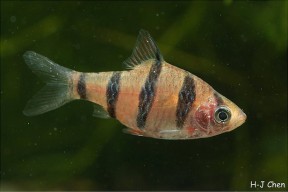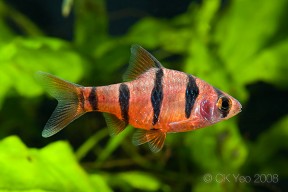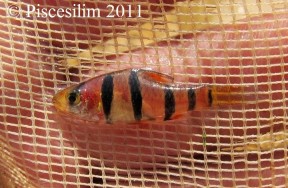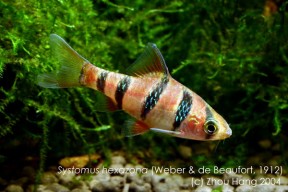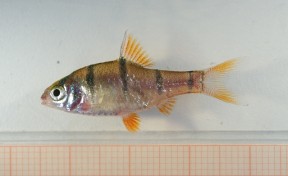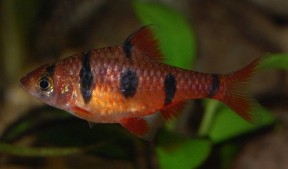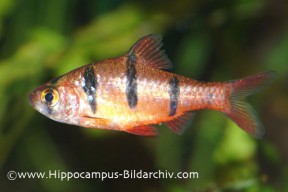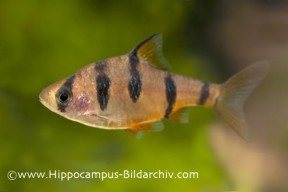Desmopuntius hexazona
'Pentazona' Barb
SynonymsTop ↑
Barbus hexazona Weber & de Beaufort, 1912; Puntius hexazona (Weber & de Beaufort, 1912); Systomus hexazona (Weber & de Beaufort,1912)
Etymology
Desmopuntius: from the Ancient Greek δεσμψτης (desmotes), meaning ‘prisoner’, and the generic name Puntius, in reference to the barred colour pattern in member species.
hexazona: from the Ancient Greek ἕξ (héks), meaning ‘six’, and Latin zona, meaning ‘zone’, in reference to this species’ colour pattern.
Classification
Order: Cypriniformes Family: Cyprinidae
Distribution
Native to parts of southern Borneo, eastern Sumatra, Singapore, and the Malay Peninsula.
In Singapore it’s considered highly-endangered and is now restricted to the Central Catchment nature reserve.
Type locality is ‘Tuluk and Gunung Sahilan, Sumatra, Indonesia’ which appears to correspond to localities within the Kampar River drainage of which the former is now known as Teluk Meranti and is one of many sites on Sumatra where the ancient peat swamp forest has been cleared to make space for oil palm plantations.
Habitat
Most often inhabits peat swamps and associated black water streams as well as other still waters, often in areas with submerged grasses or aquatic plants and dense riparian vegetation.
The water itself is typically stained brown with humic acids and other chemicals released by decaying organic material, dissolved mineral content is generally negligible and pH as low as 3.0 or 4.0.
Substrates are usually littered with fallen leaves, branches and submerged tree roots though in some places aquatic plants from genera such as Cryptocoryne or Barcalaya can be found.
In the North Selangor peat swamp, Peninsular Malaysia, sympatric fishes include Rasbora cephalotaenia, R. einthovenii, R. kalochroma, Nemacheilus selangoricus, Neohomaloptera johorensis, Kottelatlimia pristes, Mystus bimaculatus, Belontia hasselti, Betta bellica, B. livida, Sphaerichthys osphromenoides, Trichopodus trichopterus, and Luciocephalus pulcher.
Maximum Standard Length
50 – 55 mm.
Aquarium SizeTop ↑
Base dimensions of at least 80 ∗ 30 cm or equivalent are required.
Maintenance
Will thrive in a heavily-planted or forest stream-type set-up, the latter comprising a soft substrate, dim lighting, roots, branches and leaf litter.
You could also add aquatic plants that can survive under such conditions such as Microsorum, Taxiphyllum or Cryptocoryne spp.
Filtration does not need to be particularly strong as it mostly hails from sluggish waters.
Water Conditions
Temperature: 20 – 26 °C
pH: 4.0 – 7.0
Hardness: 18 – 90 ppm
Diet
Primarily a micropredator feeding on small insects, worms, crustaceans and other zooplankton in nature.
In the aquarium it will accept dried foods of a suitable size but should not be fed these exclusively.
Daily meals of small live and frozen fare such as Daphnia, Artemiaand suchlike will result in the best colouration and encourage the fish to come into breeding condition.
Behaviour and CompatibilityTop ↑
An ideal addition to a peaceful community of Southeast Asian fishes with comparably-sized, open water-dwelling cyprinids, small loaches, and certain anabantoids perhaps constituting the best choices.
Some sympatric species from Peninsular Malaysia are listed above in ‘Habitat’, many of which are available in the aquarium trade.
Avoid boisterous or very vigorous tankmates as they may outcompete it for food.
It’s a schooling species by nature, and really should be kept in a group of at least 8-10 specimens.
Maintaining it in decent numbers will not only make the fish less skittish but result in a more effective, natural-looking display, and males will also display their best colours as they compete with one other for female attention.
Sexual Dimorphism
Adult males tend to be slightly smaller, are noticeably slimmer and exhibit more intense colouration than females.
Reproduction
Like most small cyprinids Desmopuntius spp. are egg-scattering free spawners exhibiting no parental care.
When in good condition they will spawn often and in a mature aquarium it’s possible that small numbers of fry may start to appear without intervention.
However if you want to maximise yield a more controlled approach is required.
The adult group can still be conditioned together but a smaller aquarium should also be set up and filled with mature water.
This should be very dimly lit and the base covered with some kind of mesh of a large enough grade so that the eggs can fall through but small enough so that the adults cannot reach them. The widely available plastic ‘grass’-type matting can also be used and works well, as does a layer of glass marbles.
Alternatively filling much of the tank with a fine-leaved plant such as Taxiphyllum spp. or spawning mops can also return decent results.
The water itself should within the ranges suggested above, and an air-powered sponge filter or air stone(s) should also be included to provide oxygenation and water movement.
When the adults are well-conditioned and the females appear gravid one or two pairs should then be introduced, and spawning should take place the following morning.
An alternative is to spawn the fish in a group with half a dozen specimens of each sex being a good number, although a larger aquarium may be necessary.
In either situation the adults will probably eat the eggs given the chance and should be removed as soon as any are noticed.
These should hatch in 24 – 36 hours with the fry free swimming after 3-4 days.
They should be fed on an infusoria-grade food for the first few days until large enough to accept microworm, Artemia nauplii, or suchlike.
NotesTop ↑
This species is a popular aquarium fish but normally traded as the similar-looking congener D. pentazona with vernacular names including ‘pentazona barb’ and ‘six-banded barb.
The two are almost identical in terms of both appearance and morphometrics but can be immediately separated by the fact that D. pentazona possesses a small dark marking at the posterior base of the dorsal-fin which is absent in D. hexazona.
D. pentazona also has a relatively narrow distribution being restricted to northwestern Borneo, and possibly the Malaysian state of Sarawak.
D. hexazona was for a number of years referred to by the name ‘Puntius johorensis‘ (now also included in Desmopuntius) and in older literature it may be seen labelled as such.
The misapplication was resolved by Kottelat (1992) who demonstrated that D. johorensis is a larger fish which has vertical body stripes when juvenile but develops a pattern of laterally-orientated stripes at maturity.
D. hexazona and D. pentazona are both included in a group of closely-related, similar-looking fishes which were moved into the new genus Desmopuntius by Kottelat (2013). They were formerly included in the Puntius assemblage which was for a number of years viewed as a polyphyletic catch-all containing over 100 species of small to mid-sized cyprinid until Pethiyagoda et al. (2012) published a partial review covering South Asian members.
The majority of sub-Himalayan Puntius species were reclassified and new genera Dawkinsia, Dravidia (subsequently amended to Haludaria), and Pethia erected to accomodate some of them, with the remainder either retained in Puntius or moved to the existing Systomus assemblage, though the definition of the latter was altered meaning some Southeast Asian species formerly placed there could no longer be considered members.
Kottelat (2013) published a comprehensive nomenclatural update for Southeast Asian fishes in which the genus Desmopuntius was raised and diagnosed as follows: unique colour pattern made of 4–6 bars at least in juveniles, anterior bar across eye, 2nd bar behind gill opening, 3rd bar at dorsal-fin origin, 4th bar at anal-fin origin, 5th bar at middle of caudal peduncle, and 6th at caudal-fin base; often a black spot at posterior extremity of dorsal-fin base. In D. gemellus, D. johorensis and D. trifasciatus the barred pattern is present only in juveniles and with increasing size transforms into a striped pattern.
In addition, the following characters are useful in identification of Desmopuntius spp.: last simple dorsal-fin ray serrated posteriorly; rostral and maxillary barbels present; lips smooth and thin, postlabial groove interrupted medially; lateral line complete, with 25–27 pored scales on body; ½4/1/4½ scale rows between dorsal-fin origin and ventral midline in front of pelvic-fin base; 12 circumpeduncular scale rows; 7–11 gill rakers on first gill arch.
References
- Weber, M. and L. F. de Beaufort, 1912 - Von Alfred Maass... Berlin. Durch Zentral-Sumatra. Von Alfred Maass... Berlin v. 2: 522-541
Fische. - Alfred, E. R., 1963 - Bulletin of the National Museum of Singapore 32: 135-142
Some Colourful Fishes of the Genus Puntius Hamilton. - Beamish, F. W. H., R. B. Beamish, and S. L-H. Lim, 2003 - Environmental Biology of Fishes 68(1): 1-13
Fish assemblages and habitat in a Malaysian blackwater peat swamp. - Collins, R., K. F. Armstrong, R. Meier, Y. Yi, S. D. J. Brown, R. H. Cruickshank, S, Keeling, C. Johnston, 2012 - PLoS ONE 7(1): e28381
Barcoding and Border Biosecurity: Identifying Cyprinid Fishes in the Aquarium Trade. - Kottelat, M., 1992 - Raffles Bulletin of Zoology 40(2): 187-192
The identity of Barbus johorensis Duncker, 1904 (Teleostei: Cyprinidae). - Kottelat, M., 2013 - The Raffles Bulletin of Zoology Supplement 27: 1-663
The fishes of the inland waters of southeast Asia: a catalogue and core bibiography of the fishes known to occur in freshwaters, mangroves and estuaries. - Pethiyagoda, R., 2013 - Zootaxa 3646(2): 199
Haludaria, a replacement generic name for Dravidia (Teleostei: Cyprinidae). - Pethiyagoda, R., M. Meegaskumbura, and K. Maduwage, 2012 - Ichthyological Exploration of Freshwaters 23(1): 69-95
A synopsis of the South Asian fishes referred to Puntius (Pisces: Cyprinidae).

